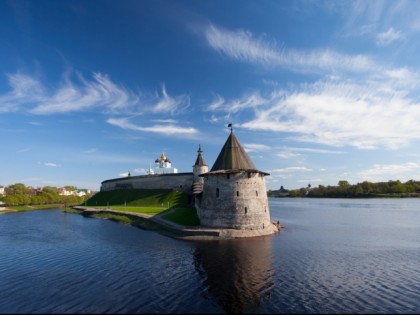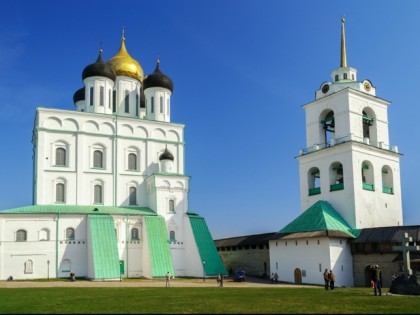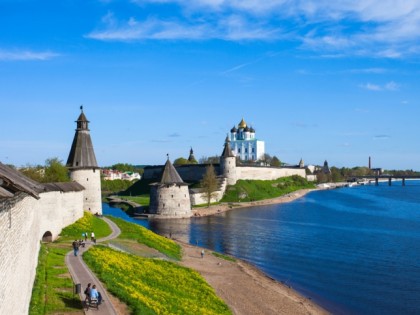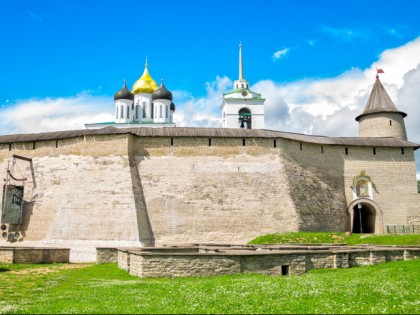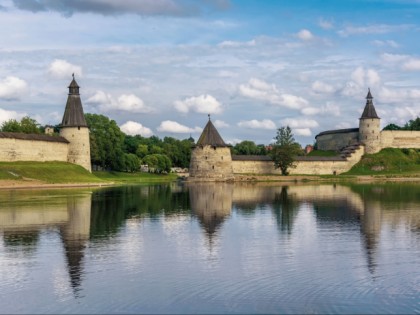Pskov Kremlin: one of the symbols of Russia
The Pskov Kremlin stands at the point where the Velikaya and Pskova rivers are connected. The first defensive revetment appeared on this site in the VIII century. Over the centuries the Kremlin survived twenty-six sieges. The complex of protective structures of the Kremlin includes the inner fortress with the Trinity Cathedral and the Veche Square and the outer part, the so-called Dovmont Town. In 2013 the Pskov Kremlin took part in the media competition "Russia-10" and entered the list of the ten main symbols of Russia!
Inside the Pskov Kremlin there is a huge Trinity Cathedral, which was erected in the 17th century and operates today. For a long time the treasury and important documents were kept inside the church. Pskov princes prayed here when going to battle. The powerful walls of the Kremlin are fortified by defensive towers. There is an observation deck at the Vlasyevskaya tower built in the XIV century, from which one can admire the surroundings. The way to the wide and squat Ploskaya tower lies through the covered passage – curtain wall. The road to the inner fortress goes through Dovmont Town, named after the Lithuanian prince Dovmont, who ruled the city for a long time and was later ranked as saint. The Pskov Kremlin is often compared to Pompeii: after all, there are more than twenty foundations of temples and household buildings here, some of which are planned to be reconstructed. There is a museum in the restored Prikaznye Palaty of 1695, the exposition of which is devoted to the history of the city during the Northern War, and on the second floor the interiors of the state prikazy (state management bodies in XV-XVIII centuries) have been recreated.
GPS coordinates
57.82059509759973, 28.329877853393555
Phone
+7 811 2724574
Official website
Opening Hours
Now - closed
Mon-Sun
10:00-18:00
Nearby

Venezia
Banquet room • Café • Pizzeria • Catering
+7 911 3812121

The Pogankin Chambers
Architectural Monuments • Museums and Exhibitions

Old Krom Grill & Pub
Restaurant • Banquet room • Bar • Hookah bar • Catering
+7 8112 298136
Payment methods:

АристократЪ
Restaurant • Banquet room
+7 911 3802020
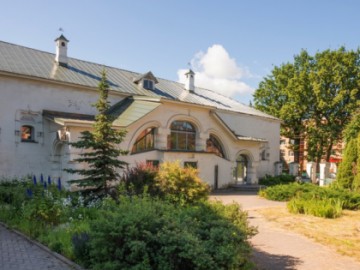
Chambers of merchant Menshikov
Museums and Exhibitions

Coffee Brabus
Coffee shop • Patisserie
+7 8112 602330
Payment methods:

U Gromycha
Restaurant • Banquet room • Hotel
+7 8112 790909
Payment methods:

Staryj Port
Banquet room • Pub • Café
+7 8112 460060
Payment methods:

Bubble Poof
Coffee shop • Patisserie
+7 921 2174211
Payment methods:

Moya Italiya
Café • Pizzeria • Catering
+7 811 2601000
Payment methods:

Shashlychnyj dvorik №1
Bistro • Fast Food • Café • Catering
+7 8112 702021
Payment methods:

Match Bar
Night Club • Pub • Sports bar
+7 911 3559000
Payment methods:

Kolos
Hotel • Café
+7 8112 723256
Payment methods:

Karl Fridriх
Restaurant • Banquet room • Pub • Catering
+7 8112 727167
Payment methods:

Bodryj den
Coffee shop • Patisserie
+7 8112 222324
Payment methods:

Pskovskie ponchiki
Coffee shop • Patisserie • Bistro • Bakery
+7 911 8876838
Payment methods:

Gremyachaya Tower
Architectural Monuments • Other places

Barsouk
Restaurant • Club • Banquet room • Hookah bar • Catering
+7 906 2211222
Payment methods:

Mojo Gastrobar
Restaurant • Catering
+7 8112 610626
Payment methods:

Dom Babinina
Banquet room • Café • Catering
+7 8112 702737
Payment methods:

Рублев
Banquet room • Bar
+7 911 3802020
Payment methods:

Legenda
Banquet room • Café
+7 8112 573521
Payment methods:

Zolotoj bambuk
Café
+7 8112 573471
Payment methods:

Rus
Restaurant • Banquet room • Café
+7 8112 720385
Payment methods:

PoZhARka
Café
+7 911 3810065
Payment methods:

Josper
Restaurant • Bar • Grill bar • Catering
+7 8112 612019
Payment methods:

Bodryj den
Coffee shop • Patisserie
+7 8112 222324
Payment methods:

Chudo Vafli
Patisserie • Café • Catering
+7 8112 610509
Payment methods:

Old School Bar
Night Club • Disco • Fast Food • Bar
+7 811 2601860
Payment methods:

Sunduk
Biergarten • Bar • Café
+7 8112 722467
Payment methods:

Old School Bar
Night Club • Disco • Bar • Hookah bar
+7 8112 601860
Payment methods:

Old Krom
Restaurant • Pub • Grill bar • Catering
+7 811 2298136
Payment methods:

Lenin Square
Other places

Double Coffee
Coffee shop • Tavern • Café • Pizzeria • Catering
+7 8112 663539
Payment methods:
